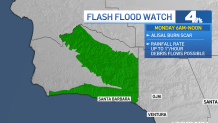Grab your sweater, your rainboots and your umbrella -- the large storm that lashed Northern California is bringing rain and cooler temperatures to the region throughout Monday.
The atmospheric river-fueled storm has already dumped historic amounts of water on San Francisco and Sacramento, breaking rainfall records and causing floods across northern and central California.
Send Us Your October Storm Photos
The same storm is expected to drop about .25 to .75 inches of rain over SoCal coasts and the valleys, and between 1 and 1.5 inches over the coastal slopes, foothills and mountains over the course of the day. Moderate to heavy rain was reported early Monday afternoon.
Get top local stories in Southern California delivered to you every morning. >Sign up for NBC LA's News Headlines newsletter.
“It’s a soggy and cool day with rain expected to intensify around the middle of the day,” said NBCLA forecaster Belen De Leon.
The rain will likely cause messy roads throughout SoCal, high surf near the coasts and even flash floods in the Alisal Fire burn scar area.
Here's when to expect the heaviest rain.
- Ventura County: Late morning
- Valleys and LA Basin: Midday
- Orange County and Inland Empire: Early Afternoon

The rain will start to pick up around midday in Los Angeles and Ventura counties. The clouds will then sweep east in the afternoon, dropping water on the Inland Empire and Orange County during the evening commute.
By the evening, just after sunset, the rain should make its exit.

Remember to slow down during the morning commute: because it's the first rain of the season, the water will mix with oil on the roadways, creating slick, slippery surfaces as light rain starts to hit the western part of the region.
Local
Get Los Angeles's latest local news on crime, entertainment, weather, schools, COVID, cost of living and more. Here's your go-to source for today's LA news.
The heaviest period of rain may also cause some localized street flooding. Gusty winds may cause some difficulties while driving, especially in the mountains.
There's a wind advisory in place for the mountains and deserts from 6 a.m. Monday all the way until 2 a.m. Tuesday, with gusts up to 55 miles per hour in some areas. Secure loose objects, like Halloween decorations, so they don't fly away in the breeze.
While most of the burn scars severe enough to cause mudslides or debris flows fall outside SoCal, the area of the Alisal Fire burn scar in Santa Barbara County will see some of the heaviest rain from the system.
Rain started in the county early in the morning, with the main front over Santa Barbara by 8:45 a.m.
With a flash flood warning in effect from 6 a.m. Monday until noon, county officials issued evacuation orders late Sunday morning for some residents.

At the coasts, high surf advisories are in place, with waves as high as 6 to 12 feet.
Temperatures will stay cool as the rain system moves through the region, with highs only reaching the 60s. However, any snow is expected to stay above about 8,000 feet, due to the tropical nature of the storm.
Photos: October Storm Lashes California
Recent storms have helped contain some of the nation’s largest wildfires this year. But it remains to be seen if the wet weather will make a dent in the drought that’s plaguing California and the western United States.
California’s climate is hotter and drier now and that means the rain and snow that does fall is more likely to evaporate and less likely to absorb into the soil.
California’s 2021 water year, which ended Sept. 30, was the second driest on record and last year’s was the fifth driest on record. Some of the state’s most important reservoirs are at record low levels.



